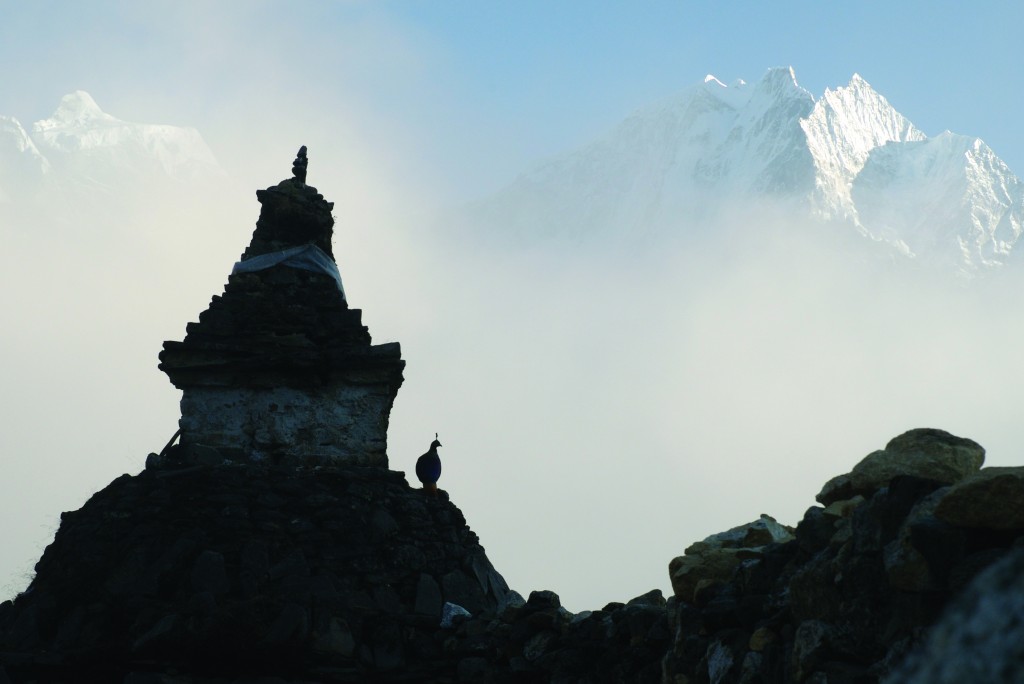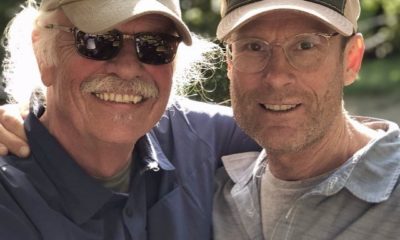Uncategorized
Flashpoint
Published
10 years agoon
Danuru Sherpa represents a new breed of Himalayan guide By Terry Cunningham Explore Big Sky Contributor Danuru Sherpa and John Dahlem’s headlamps lit the riot of wind-whipped ice pellets peppering their faces like buckshot, plinking against their oxygen masks. It was 4 a.m. on May 24, 2010, and the men were at 28,500 feet on Mount Everest’s southeast ridge. They braced themselves as another 50-mile-an-hour gust threatened to blow them tumbling 8,000 feet into Nepal. Dahlem, 67 and a retired school principal, looked back at his 34-year-old guide Danuru, who flashed a broad smile accented by a single gold tooth and motioned upward. Several steps later, Dahlem was suddenly unable to breathe. “It felt like there was a hand clamped over my mouth. I thought I was having a heart attack,” he recalls. He gestured madly to Danuru, who knew immediately what was happening. The Sherpa smacked Dahlem’s oxygen mask, knocking ice chunks from it. But he still wasn’t getting air. “Then he leaned in like he was gonna kiss me,” Dahlem says. Danuru, a native of Phortse, Nepal, placed his lips over a thin tube venting Dahlem’s oxygen mask and, with a sharp puff, blew a hunk of frozen sweat and snot back into the mask, unclogging the system. For Dahlem, standing atop Mount Everest in 2010 was a stepping stone in his goal of completing the Adventurer’s Grand Slam: surmounting the highest summit on each of the seven continents, and reaching the north and south poles. For Danuru Sherpa – who Bozeman alpinist Conrad Anker describes as “one of the two or three strongest people on [Everest]” – the goal was to earn enough money to send his daughters, now ages 13 and 11, to school in Kathmandu.


Looking toward Tengboche monastery in Phortse, Nepal, Ama Dablam in the background. Phortse is the home of the Khumbu Climbing Center, which works to reduce what co-founder Conrad Anker calls “the alarmingly high fatality rate among the native high-altitude workers.” PHOTO BY JENNIFER LOWE-ANKER
Since the late 19th century, western expeditions have employed Sherpas to haul heavy loads and establish high-altitude camps on 8,000-meter peaks including Everest, despite their lack of technical or rescue training. A significant flashpoint in the Sherpa-Westerner relationship occurred on Everest in 2013, when three European solo climbers ignored the pleas of a Sherpa rope-fixing crew not to traverse the icy slopes of the Lhotse Face above them. The Europeans then inadvertently knocked down chunks of ice toward the rope-fixers and rebuffed the Sherpas’ subsequent challenge with a deluge of vile insults. Danuru was at Camp I when a group of furious Sherpas confronted the solo climbers at Camp II. “Very angry talk,” he says of the melee in an excited tone. “[Western man] make the first punch and then big fight with fist and rock.” The brawl – which was portrayed very differently by the Westerners involved – became the subject of world headlines in the weeks that followed. “They don’t listen when we ask please wait,” Danuru said, shaking his head. “Need respect to Sherpa more. Climbing is Sherpa way to make money, change our life.” Anker is more direct. “This altercation should serve as a wake-up call for ‘Westies’ to quit treating [Sherpas] like trash and slaves.” __________ Danuru was 18 when he met Anker and Dave Hahn, both renowned American climbers now with myriad Everest summits. The year was 1999, and all three were part of the expedition that discovered famed British mountaineer George Mallory’s body on the north side of Everest. 



Danuru, pictured here with his family in Phortse, guides at high elevation to support his daughters’ education. PHOTO BY JENNIFER LOWE-ANKER
Danuru’s humility reflects a culture that values modesty and deference – something that doesn’t necessarily best serve Sherpas guiding well-heeled, type-A clients on 8,000-meter peaks. In the fall of 2002, Danuru tried to turn around slow moving Korean clients just below the Hillary Step for timing and safety concerns. “Client say: ‘We spend lots of money to come here. Almost there. We go up!’” Danuru recalls. After several calls to Base Camp, they finally heeded the Sherpa’s advice. Hahn believes Danuru has outgrown his current role as a personal guide for one or two clients at a time, and is capable of leading expeditions. “I don’t like keep working on the mountain too long, but I need to make money for education for daughters,” Danuru says with a sigh. This is also cultural, Anker says. “Their biggest investment is in their children’s education. Improving your place in life is the social bling in the Sherpa community.” Given the complex risk/reward calculus of high-altitude mountaineering, one can only hope Danuru Sherpa will know when the time is right to hang up his crampons.
This story was first published in the winter 2013/2014 issue of Mountain Outlaw magazine.
Megan Paulson is the Co-Founder and Chief Operating Officer of Outlaw Partners.


Upcoming Events
april, 2024
Event Type :
All
All
Arts
Education
Music
Other
Sports
Event Details
Children turning 5 on or before 9/10/2024:
more
Event Details
Children turning 5 on or before
9/10/2024: Kindergarten
enrollment for the 2024-2025 school year can be completed by following the
registration process now.
Children
born on or after September 11, 2019: 4K enrollment is now open for
families that have a 4-year-old they would like to enroll in our program for
the 2023-2024 school year. Please complete the 4K Interest Form to
express your interest. Completing this form does not guarantee enrollment into
the 4K program. Enrollment is capped at twenty 4-year-olds currently
residing within Big Sky School District boundary full time and will be
determined by birth date in calendar order of those born on or after September
11, 2018. Interest form closes on May 30th.
Enrollment now is critical for fall preparations. Thank you!
Time
February 26 (Monday) - April 21 (Sunday)
Event Details
Saturday, March 23rd 6:00-8:00pm We will combine the heart-opening powers of cacao with the transcendental powers of breathwork and sound. Together, these practices will give us the opportunity for a deep
more
Event Details
Saturday, March 23rd 6:00-8:00pm
Time
March 23 (Saturday) 6:00 pm - April 23 (Tuesday) 8:00 pm
Location
Santosha Wellness Center
169 Snowy Mountain Circle
Event Details
We all are familiar with using a limited palette, but do you use one? Do you know how to use a
more
Event Details
We all are familiar with using a limited palette, but do you use one? Do you know how to use a limited palette to create different color combinations? Are you tired of carrying around 15-20 different tubes when you paint plein air? Have you ever wanted to create a certain “mood” in a painting but failed? Do you create a lot of mud? Do you struggle to achieve color harmony? All these problems are addressed in John’s workbook in clear and concise language!
Based on the bestselling “Limited Palatte, Unlimited Color” workbook written by John Pototschnik, the workshop is run by Maggie Shane and Annie McCoy, accomplished landscape (acrylic) and plein air (oil) artists,exhibitors at the Big Sky Artists’ Studio & Gallery and members of the Big Sky Artists Collective.
Each student will receive a copy of “Limited Palette, Unlimited Color” to keep and take home to continue your limited palette journey. We will show you how to use the color wheel and mix your own clean mixtures to successfully create a mood for your paintings.
Each day, we will create a different limited palette color chart and paint a version of a simple landscape using John’s directives. You will then be able to go home and paint more schemes using the book for guidance.
Workshop is open to painters (oil or acrylic) of any level although students must have some basic knowledge of the medium he or she uses. Students will be provided the book ($92 value), color wheel, value scale and canvas papers to complete the daily exercises.
Sundays, April 14, 21 and 28, 2024
Noon until 6PM.
$170.
Time
14 (Sunday) 12:00 pm - 28 (Sunday) 6:00 pm
Event Details
Everyone is invited to join us in celebrating 2 years of arts education in the BASE Art Studio with us! Take a tour
Event Details
Everyone is invited to join us in celebrating 2 years of arts education in the BASE Art Studio with us! Take a tour of the studio, meet our instructors, and meet other artists of all levels in our community. We’ll be getting creative and you’ll have the chance to make your very own artful button pin.
Stick around for our Volunteer Appreciation and Social beginning at 6:30 p.m.!
Time
(Thursday) 5:30 pm - 6:30 pm
Location
BASE
285 Simkins Dr










